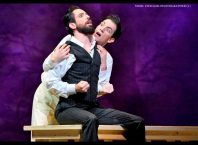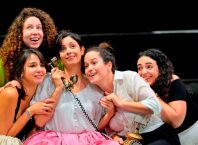A play of boundaries and their transgression, William Shakespeare’s A Midsummer Night’s Dream comes to playful, sensual, life in the Khan Theatre production directed by Shir Goldberg. The spectacular ensemble cast dazzles and delights on this excursion into forest and faerie. The play is edited by Shahar Pinkas, and the translation by Dori Parnes into Hebrew revels in wonderful freedom, full of fun and frolic.
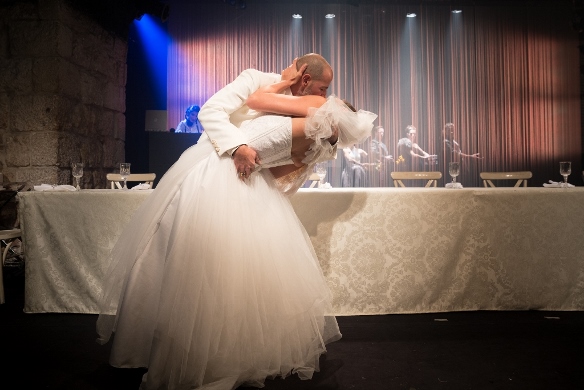
The play opens on the nuptials of Theseus, Duke of Athens (Yossi Eini), and Hippolyta (Carmit Mesilati-Kaplan) who appears barely resigned to her fate, and determined to drown her sorrows in drink, reminding the audience that, according to some legends, she is indeed a conquest, as much captive as bride. The set is emphatically traditional: long table covered in a white tablecloth with tastefully arranged low centerpieces of white flowers, and a many-tiered white cake topped by a tiny bride and groom. Weddings impose order on the passions, legitimize lust; love is something else altogether. Athens is the realm of law and order, ruled over by Theseus, while in the wood the fairies weave their magic and mischief.
Exploring the boundaries between men and women, dreaming and waking, fantasy and reality, order and passion, the tables are literally turned, as the tables and chairs of the wedding furniture are transformed into the wood at night. As the lovers wander in the wood at night, finding and losing one another by turns, the actors crawl over and under the tables and chairs, reminiscent of childhood games of pretend, that world of fantasy within. Natasha Tuchman Polyak’s fanciful costumes underscore the play’s themes, the formal wear of the Athenians marked by whimsical departures – a feathered collar, a fur skirt, or an ample adornment of scales on a severe gray suit.
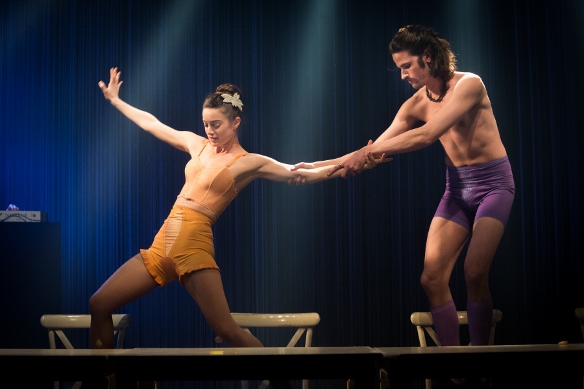
It is a production that emphasizes the sensual aspect of Shakespeare’s play. The world of the wood is marked by the bare torsos and clinging, colorful shorts of the men, and the enticing lingerie of the women. Mesilati-Kaplan and Eini tear off their wedding vestments, signalling the transition to the dream world, and their dual roles as Titania and Oberon. Dance sequences choreographed by Ariel Wolf, punctuate the action, at once stylized and sexy, they denote the ritual aspect of marriage and other social conventions, sensuality both expressed and constrained.
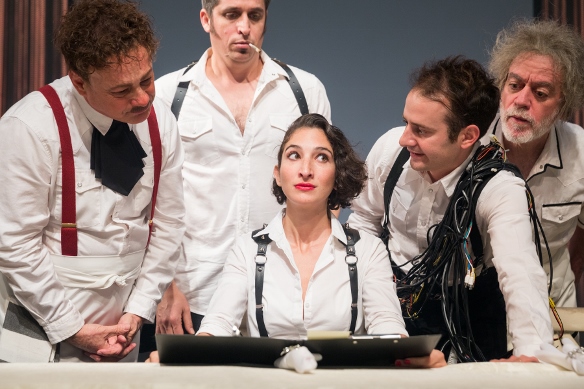
The play within a play is hilarious, with the more sedate Peter Quince here transformed in the more risqué Lady D.J. (Natalie Eliezerov) in her studded suspenders and leather skirt. Erez Shafrir reaches new comic heights in his dual (or is it triple?) role as Bottom the waiter. Constantly fluffing his hair, his transformation into an ass, and the intrepid lover Pyramus. Bottom’s distortion of words, his thespian enthusiasm and vanity are imbued with a childlike innocence. Shafrir’s physicality truly transforms him, as much as the costume, yet this is a gentle beast, and something about his quality of movement and those curly ears make him quite loveable. Nir Ron is an unlikely, yet utterly magical and mischievous Puck, with his angularity and long limbs. Yehoyachin Friedlander takes on a dual role as Egeus, the stern, oppressive father of Hermia, willing to kill his daughter if she dare not obey, and also Sponge, the cleaning man. Here too, although the costume contributes, the wonder is in Friedlander’s transformation, as the (mostly silent) Sponge: his features grow lax, eyes wide and dull, his entire presence slack, one might say sponge-like, passive and amiable.
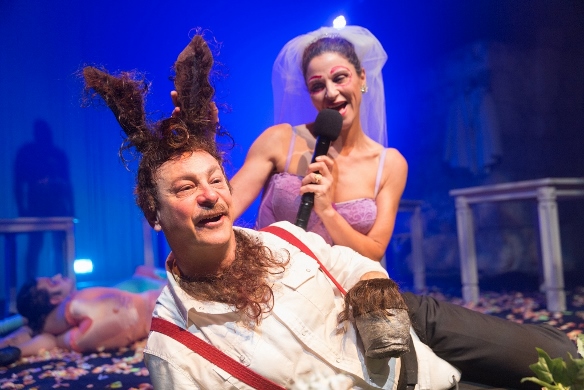
This production gives Nili Rogel free rein to flex her comic muscles as Helena, and she runs with it beautifully. Whether spurned or surrounded, her expressive outpouring of thoughts and feelings always amuse, as does her gangly yet swift and supple physical embodiment of the character, with lively spontaneity and comic timing. Laughs abound in the girlfight between Helena and Hermia, with the delicate Daniel Gal stepping up and showing her gang-worthy mettle, and other surprises.
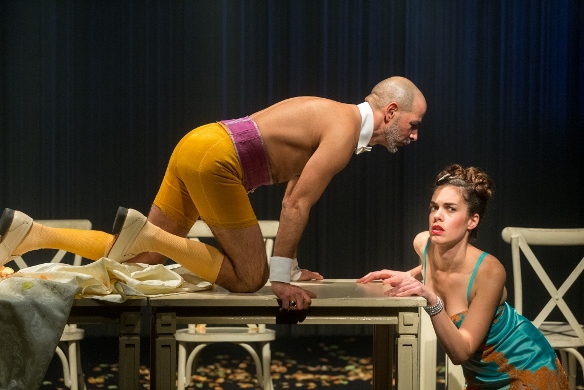
A Midsummer Night’s Dream is an extremely self-referential play, boasting not only a play within a play but rehearsals and director’s instructions to the actors, as well as Puck’s epilogue. If indeed, we “have but slumb’red here/while these visions did appear” then the theatre is our wood, that place of magic and fantasy where everything is chaotic and yet somehow right and true. Out there is Athens, with all it implies, and we need to go into the wood sometimes and let it work its enchantment on us.
A Midsummer Night’s Dream
A comedy by William Shakespeare; Translation: Dori Parnes; Directed by Shir Goldberg; Editing: Shahar Pinkas; Set Design: Adam Keler; Costume Design: Natasha Tuchman Polyak; Music: Daniel Salomon; Lighting Design: Roni Cohen; Choreography: Ariel Wolf; Video Art: Amir Tal; Dialogue Coach: Asi Eshed; Cast: Yossi Eini – Theseus/Oberon, Carmit Mesilati-Kaplan – Hippolyta/Titania, Nir Ron – Philostrate/Puck, Lior Blaus – Narrisa, Bridesmaid/Titania’s maid, Yehoyachin Friedlander – Egeus, Hermia’s father/Sponge the Cleaning Man, Guy Gurevich – Demetrius, Nili Rogel – Helena, Ariel Wolf – Lysander, Daniel Gal – Hermia, Natalie Eliezerov – Lady D.J./Director of play, Yoav Hyman – Zoom, a photographer/Thisbe, Erez Shafrir – Bottom the Waiter/Pyramus, Itai Szor – Clap, assistant photographer/Lion




